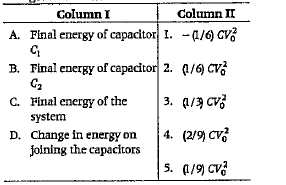A capacitor of capacitance C is charged to a potential differece V0. The terminals of the charged capacitor are then connected to those of an uncharged capacitor of capacitance C/2.
a. Compute the original charge of the system.
b. Find the final potential differce across each capacitor.
c. Find the final energy of the system.
d. Calculate the decrease in energy when the capacitors are connected.
e. Where did the ''lost'' energy go?
Q=CV0
They have equal potential difference, and thir combined charge must add up to the original charge Therefore,
V=Q1C1=Q2C2 and also Q1+Q2=CV0
C1=C and C2=C2,
So Q1C=Q2(C/2)
or Q2=Q1Q2
or Q=32Q1orQ1=23Q
So V=Q1C1=23QC=23V0
c. U=12(Q21C1+Q22C2)=12⎡⎢
⎢
⎢⎣(23Q)2C+2(13Q)2C⎤⎥
⎥
⎥⎦
=12Q2C=12CV20
d. The original U was U=12CV20 or ΔU=−16CV20.
Thermal energy of capacitor, wires, etc., and electromagnetic radiation.
Related Playlists
- BOOK - CENGAGE PHYSICSCHAPTER - CAPACITOR AND CAPACITANCEEXERCISE - Subjective24videos
CAPACITOR AND CAPACITANCE
- BOOK - CENGAGE PHYSICSCHAPTER - CAPACITOR AND CAPACITANCEEXERCISE - Single Correct49videos
CAPACITOR AND CAPACITANCE
- BOOK - CENGAGE PHYSICSCHAPTER - CAPACITOR AND CAPACITANCEEXERCISE - Exercise 4.113videos
CAPACITOR AND CAPACITANCE
- BOOK - CENGAGE PHYSICSCHAPTER - ATOMSEXERCISE - QUESTION BANK40videos
ATOMS
- BOOK - CENGAGE PHYSICSCHAPTER - CENGAGE PHYSICS DPPEXERCISE - subjective type51videos
CENGAGE PHYSICS DPP
Similar Practice Problems
- Question 1 - Select One
A capacitor C1 of capacitance C is charged to a potential difference V0. The terminal of the charged capacitor are then connected to an uncharged capacitor C2of capacitance C/2. Match the entries of Column I with the entries of Column II and choose the correct option from the codes given below.
 A
A B
B C
C D
D
- Question 1 - Select One
A 10μF capacitor is charged to a potential difference of 1000V. The terminals of the charged capacitor are disconnected from the power supply and connected to the terminals of an uncharged 6μF capacitor. What is the final potential difference across each capacitor ?
A167VB100VC625VD250V - Question 1 - Select One
A capacitor or capacitance C1 is charge to a potential V and then connected in parallel to an uncharged capacitor of capacitance C2. The fianl potential difference across each capacitor will be
AC1VC1+C2BC2VC1+C2C1+C2C1D1−C2C1 - Question 1 - Select One or More
A capacitor of capacitance C1 is charged to a potential difference V and then connected with an uncharged capacitor of capacitance C2 a resistance R. The switch is closed at t = 0. Choose the correct option(s):
AThe initial current through the resistance is VRBThe current through the resistance as a function of time is i(t)=VRe−tτ where τ=R(C1C2C1+C2)CThe charge on capacitor C1 as a function of time is q1(t)=(C1VC1+C2)(C1+C2e−tτ)DAfter a long time, the potential difference across the capacitor C1is(C1C1+C2)V - Question 1 - Select One
A capacitor of capacitance C is charged to a potential difference V0. The charged battery is disconnected and the capacitor is connected to a capacitor of unknown capacitance Cx. The potential difference across the combination is V. The value of Cx should be
AC(V0−V)VBC(V−V0)VCCVV0DCV0V
Similar Questions
Find charge on each capacitor and potential difference across each capacitor .
 View Solution
View SolutionA capacitor of capacitance C is charged upto a potential difference V. After removing the charging battery, the capacitor is connected (i) in parallel, (ii) in series with an uncharged capacitor of the same capacitance. What will be the effect on the potential difference of the first capacitor in each case?
View SolutionA capacitor of capacity C0 is charged to certain potential and enrgy stored in it is U0. Now this capacitor is connected in parrallel to uncharged capacitor of capacitance. C. Find the loss of energy.
View SolutionAn isolated capacitor of unknown capacitance has been charged to potential V0. This capacitor is then connected to an uncharged capacitor of capacity C. If common potential is V(<V0, find unknow capacitance.
View SolutionA parallel plate capacitor of capacitance C has been charged, so that the potential difference between its plates is V. Now, the plates of this capacitor are connected to another uncharged capacitor of capacitance 2C. Find the common potential acquired by the system and loss of energy.
View Solution

